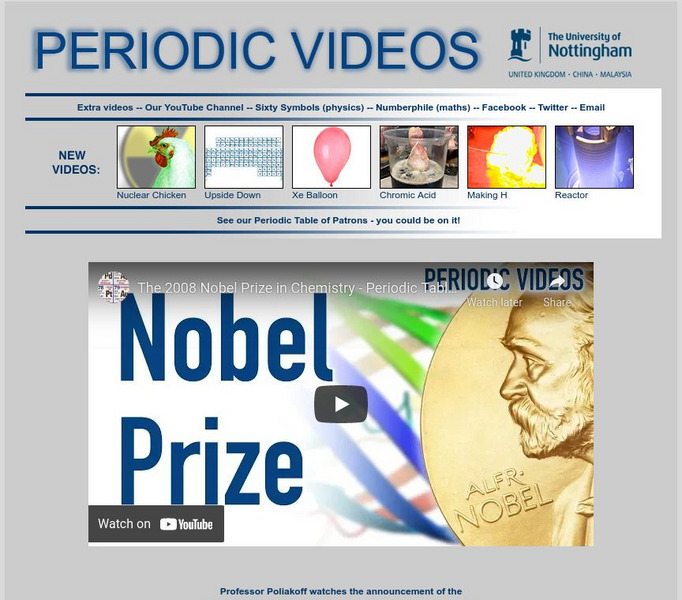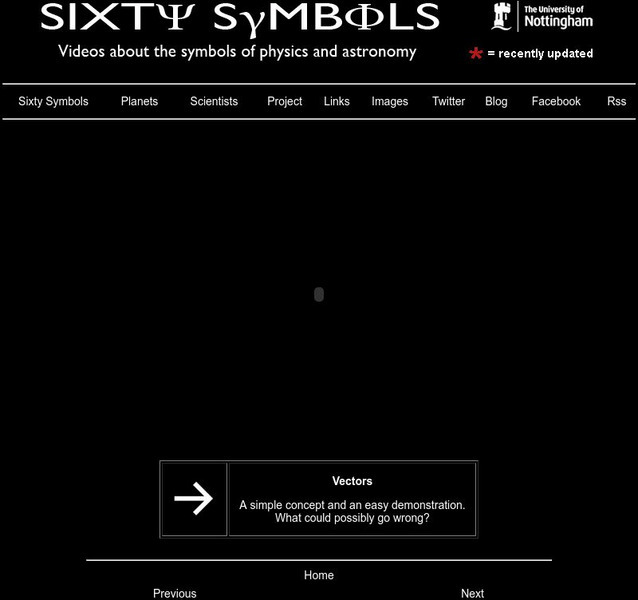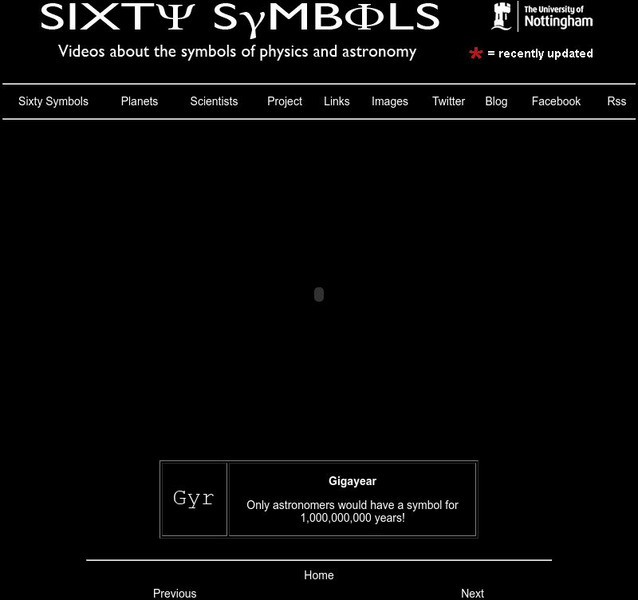Hi, what do you want to do?
University of Nottingham
University of Nottingham: Periodic Table of Videos: Tennessine
Video discussing the properties and uses of the element Tennessine. [4:03]
University of Nottingham
University of Nottingham: Periodic Table of Videos: Livermorium
Video discussing the properties and uses of the element Livermorium. [4:11]
University of Nottingham
University of Nottingham: Periodic Table of Videos: Moscovium
Video discussing the properties and uses of the element Moscovium. [7:54]
University of Nottingham
University of Nottingham: Periodic Table of Videos: Flerovium
Video discussing the properties and uses of the element Flerovium. [7:26]
University of Nottingham
University of Nottingham: Periodic Table of Videos: Nihonium
Video discussing the properties and uses of the element Nihonium. [10:23]
University of Nottingham
Sixty Symbols: Symbols of Physics and Astronomy: The Sun
University of Nottingham scientists discuss the characteristics of the Sun, which, in spite of it being crucial to life on Earth, is very ordinary. Learn why. [5:42]
University of Nottingham
Sixty Symbols: Symbols of Physics and Astronomy: Degree of an Angle
A look at what a "degree" is, and how important the degree of an angle is in different areas of science, including Earth and space science, physics, and chemistry. See how the Earth's tilt (23.5 degrees), for example, causes the changing...
University of Nottingham
Periodic Table of Videos: The $8,539 Book and Silicon 29
Why would a text on silicon-29 cost over $8,000? Debbie Kays, a lecturer in inorganic chemistry at the University of Nottingham, tackles this question, first explaining why silicon-29 is so important and then offering reasons why the...
University of Nottingham
Periodic Table of Videos: Mercury Bell
See the element mercury in solid form, frozen in the shape of a bell. Dr. Andrea Sella explains the process of making the bell and why he made it, while highlighting some important properties of mercury. [5:05]
University of Nottingham
Periodic Table of Videos: The Nobel Prize for Chemistry 2008
Professor Poliakoff of the University of Nottingham watches the announcement of the 2008 Nobel Prize in chemistry, and then talks about the winners and their work with green fluorescent protein. [6:10]
University of Nottingham
Sixty Symbols: Symbols of Physics and Astronomy: Speed of Light
The speed of light, in physics, is represented by "c", and is the topic explored by University of Nottingham physicists in this video. Watch as they talk about relative speed and measuring the speed of light. [7:32]
University of Nottingham
Sixty Symbols: Symbols of Physics and Astronomy: Magnetic Susceptibility
University of Nottingham's Dr. Richard Hill explains magnetic susceptibility and how, using a powerful magnet, he can make a drop of beer to levitate. [7:58]
University of Nottingham
Sixty Symbols: Symbols of Physics and Astronomy: Jupiter
First seen by Galileo in 1610, Jupiter is known for its many moons, its massive size, and its use in the first measurement of the speed of light. University of Nottingham physicists discuss what we've learned about Jupiter since its...
University of Nottingham
Sixty Symbols: Symbols of Physics and Astronomy: Venus
Astronomy Meghan Gray explains the origins of Venus' symbol, and offers a brief look at Earth's "sister planet" and the characteristics that make it similar to Earth. Learn why Venus is dangerous and inhabitable, not only to humans but...
University of Nottingham
Sixty Symbols: Symbols of Physics and Astronomy: Pluto
Why was Pluto, a member of the Kuiper belt, demoted, no longer a planet according to the International Astronomical Union? Astronomer Meghan Gray takes a look at this dwarf planet's characteristics, and what makes it different from the...
University of Nottingham
Sixty Symbols: Symbols of Physics and Astronomy: Polarisation
University of Nottingham's Professor Roger Bowley shows you a piece of polaroid--the type of material in sunglasses--and demonstrates how the direction of its molecules prevents glare. [8:43]
University of Nottingham
Sixty Symbols: Symbols of Physics and Astronomy: Gravitational Constant
University of Nottingham scientists discuss the importance of big "G", or Newton's universal gravitational constant, and little "g", or the force of gravity here on Earth. [8:45]
University of Nottingham
Sixty Symbols: Symbols of Physics and Astronomy: Electrons
University of Nottingham scientists discuss electrons: their mass, dimensions, movements, behavior, and other concepts that are too elusive to fully understand, even for physicists. An interesting look at experiments that help us grasp...
University of Nottingham
Sixty Symbols: Symbols of Physics and Astronomy: Dimensional Analysis
Real-life example of dimensional analysis being used to determine how big an atomic bomb really was, based on information given in magazine photos. [5:51]
University of Nottingham
Sixty Symbols: Symbols of Physics and Astronomy: Propulsion Efficiency
A University of Nottingham physicist explains how a jet engine works, and demonstrates a jet engine's propulsion efficiency using a water-propelled rocket made from a soda bottle. [6:01]
University of Nottingham
Sixty Symbols: Symbols of Physics and Astronomy: Vectors
University of Nottingham astronomer Meghan Gray introduces us to a fairly simple physics concept: the vector, defined as "something that has a size and a direction." Learn about everyday vector quantities, such as velocity, acceleration,...
University of Nottingham
Sixty Symbols: Symbols of Physics and Astronomy: Telescope Diamater
University of Nottingham astronomers talk about telescope diameter, and how the size and quality of a telescope's mirror determine what we see when looking through it. Offers a look at the opportunities offered by the "Extremely Large...
University of Nottingham
Sixty Symbols: Symbols of Physics and Astronomy: Saturn
A close-up look at Saturn, its rings, and its moons is provided thanks to the Hubble and the Cassini mission images. University of Nottinham astronomers offer a look at what we've learned about Saturn, since discovered by Galileo,...
University of Nottingham
Sixty Symbols: Symbols of Physics and Astronomy: Energy
University of Nottingham professors discuss energy, and show the conversion of potential energy to kinetic energy through a variety of simple demonstrations. [4:25]
























